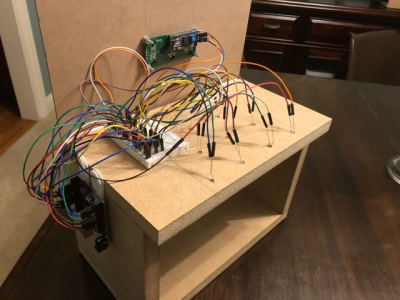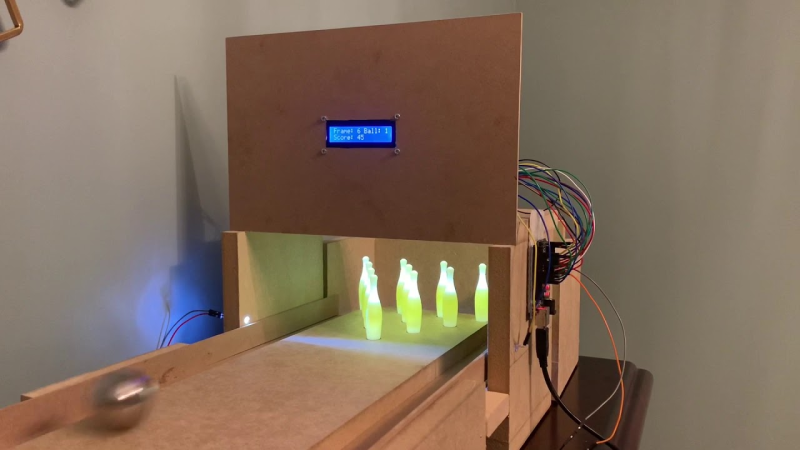Bowling has been around since ancient Egypt and continues to entertain people of all ages, especially once they roll out the fog machine and hit the blacklights. But why pay all that money to don used shoes and drink watered-down beer? Just build a tabletop bowling alley in your spare time and you can bowl barefoot if you want.
 Those glowing pins aren’t just for looks — the LEDs underneath them are part of the scoring system. Whenever a pin is knocked out of its countersunk hole, the LED underneath is exposed and shines its light on a corresponding light-dependent resistor positioned overhead. An Arduino Uno keeps track of of the frame, ball number, and score, and displays it on an LCD.
Those glowing pins aren’t just for looks — the LEDs underneath them are part of the scoring system. Whenever a pin is knocked out of its countersunk hole, the LED underneath is exposed and shines its light on a corresponding light-dependent resistor positioned overhead. An Arduino Uno keeps track of of the frame, ball number, and score, and displays it on an LCD.
The lane is nearly six feet long, so this is more like medium-format bowling or maybe even skee-bowling. There are probably a number of things one could use for balls, but [lainealison] is using large ball bearings. Roll past the break to see it in action, but don’t go over the line!
Can’t keep your balls out of the gutter? Build a magic ball and make all wishful leaning more meaningful as you steer it down the lane with your body.
















aw no reracking
Yeah, I was hoping to see a homemade pin setter and ball return.
I would try this with a smaller ball bearing and see what the smallest one is that can still do strikes, but still be a challenge to hit many pins with.
It looks like the code waits until the ball crosses a line just in front of the pins, waits 2 seconds, then reads which pins were knocked down. Doesn’t seem like it can handle a few of the cases in the video where a knocked-down pin rolls over top one or more of the LEDS.
@lainealison is using photo-resistors or CdS devices. They have a conductive band with many states and can take up to seconds to decay to a non conductive state. This is likely the reason for the 2 second delay.
Pffft kids today think they’re too good for the gold old OC71 with the paint scratched off… :-D
Yeah I know, the olde junkbox staple has gone somewhat exotic.
* good ood .. glld lld .. godd odd .. good old.. there we go.
I wonder if it wouldn’t work better to have reflective foil on the bottoms of the pins and both an LED and a detector on the floor for each pin. This way it won’t misdetect pins covering holes horizontally.
Yes, that was the solution that occurred to me.
This project screams out for lasers! They’re as cheap as leds these days, you could have the bottle middles block their path at various angles, and detectors on the opposite side. Once aligned, it would be impossible for another bottle to cause a false reading.
Wow! I hadn’t thought of using lasers to knock down the pins!
Where can I get lasers for a penny each?
Here’s a popular Dutch game similar in spirit, but you can throw 20 pucks before you have to collect them again.
https://www.youtube.com/watch?v=a3igB8JbLGs
Here’s the closest thing I knew of in England. Played both the round the pole table skittles and the throw a puck type..
https://www.tradgames.org.uk/games/Table-Skittles.htm
Interestingly, one of the table skittles boards I used had an “automatic” reset on, and it was made in the 1920s I believe… All the pins were threaded to a thin cord, through a hole on the board, so when the game was over you pulled a lever which pulled them all upright back into place.
I was going to say a servo and some fishing line could make this a self resetting game.
Well pole table skittles would obviate the need for a ball return.
Something i saw in different articles here: Is there a reason to store photographs as PNG? I understand for schematics and stuff, but for photographs better use JPG no?
If you slide the compression slider all the way across, you can get 3 rolls of film on a floppy disk too.